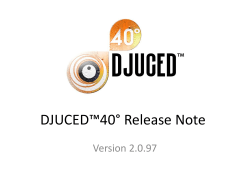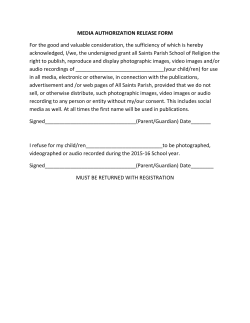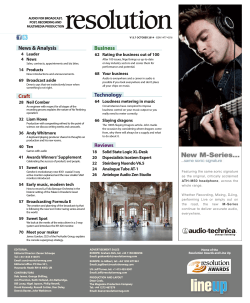
Slides - Linux Audio Conference
Audio Measurements Workshop (part 2) Fons Adriaensen Huawei Europen Research Center, M¨unchen Linux Audio Conference 2015 JGU Mainz, Germany 1 ζ Overview • Theory. * No theory today. See slides of part 1. • Quick intro to some tools * jaaa, jnoisemeter * python, numpy, scipy, pyaudiotools * matplotlib, pyqtgraphics • Howto measure * Noise levels, S/N ratio * Frequency response * Harmonic distortion * Intermodulation distortion • Practice as we go along. Audio Measurements Workshop – 1 Linux Audio Conference – April 2015 – JGU Mainz c 2015 F.Adriaensen 2 ζ Philosofical issues (again) • Why measure things ? * Verify your design and programming. * Have you been ripped off ? * To know limits and create a level of confidence. * Curiosity. • Always expect the unexpected. It happens. If your measurements are exactly as you imagined they would be, then * Congratulations ! * It’s time to verify things and ask some questions. • It’s very easy to overlook things and get completely wrong results. – Always double check and ask yourself ’can this be true’, and if yes, how ? Audio Measurements Workshop – 2 Linux Audio Conference – April 2015 – JGU Mainz c 2015 F.Adriaensen 3 ζ Jaaa • Technical spectrum analyser. • Accurately measure sine waves in noise and noise density. Audio Measurements Workshop – 3 Linux Audio Conference – April 2015 – JGU Mainz c 2015 F.Adriaensen 4 ζ Jnoisemeter Filters Detectors INPUTS RMS DC 20 k DISP Avrg A ITU C ITU OUTPUT • Measure noise according to various standards. • Filtered signal available at output. Audio Measurements Workshop – 4 Linux Audio Conference – April 2015 – JGU Mainz c 2015 F.Adriaensen 5 ζ Python and friends • python : interpreted OO language, many extensions. – numpy : efficient calculations on arrays of any dimension. – scipy : scientific computation – matplotlib, pyqtgraph : 2d and 3d plotting. – pyqt : Qt bindings to python, much easier to use than plain Qt. • pyaudiotools : collection of python classes for audio. – AudioFile : read/write audio files to/from numpy arrays. – JackSignal : Jack client, generate and capture arbitrary test signals from/to numpy arrays. – Vresampler : Resampling of numpy arrays. – Others not directly targeted at measurement. • Combining all these makes it easy to create ad-hoc automated measuring tools of any comlexity. Audio Measurements Workshop – 5 Linux Audio Conference – April 2015 – JGU Mainz c 2015 F.Adriaensen 6 Other uses of pyaudiotools : quickly build complex audio systems N2J GC NETWORK Video renderer timestamps for A/V synchronisation N2J GC GC ζ Second room Microphone Surround Proprietary 8 Soundcard Interface AUDIO HW 8 48 48 Processor Surround speakers 48 GC Proprietary Processor Linear array 48 GC J2N GC Proprietary Processor Return channel Gains and parameters controlled by ’mixer’ GUI HW SW JACK Client • All Jack modules are python classes. • All parameters controlled by PyQt Gui. • Complete system runs on Linux, OSX and Windows. Audio Measurements Workshop – 6 Linux Audio Conference – April 2015 – JGU Mainz c 2015 F.Adriaensen 7 ζ Matplotlib • Versatile python library for 2d and 3d plotting, actively developed. • Some combined DSP/plotting code inherited from early releases, better ignore this. Current development concentrates on plotting only. • Requires some getting used to, mainly because there are 3 APIs and these get mixed up in documentation and example code. – pylab : high level, stateful, MatLab style one-liners. DEPRECATED – pyplot : medium level, stateful, for interactive use. – object oriented : full control, required when combining with PyQt as pyplot uses a viewer which has its own event loop (and there can be only one). • Advice: study the OO API. Audio Measurements Workshop – 7 Linux Audio Conference – April 2015 – JGU Mainz c 2015 F.Adriaensen 8 ζ Pyqtgraph • Python library for scientific/engineering data visualisation. – High quality presentation of complex data. – Complex interactive multiple-view displays. – Very efficient, 3D graphics use OpenGL. – Integrates perfectly with PyQt, adds its own set of specialised widgets. • Adds some high level functionality: – LabView style flowchart of processing modules. – Parameter tree with graphic editor. • Lots of ’not yet implemented’ details, but actively developed. • Advice: keep an eye on this. Audio Measurements Workshop – 8 Linux Audio Conference – April 2015 – JGU Mainz c 2015 F.Adriaensen 9 Noise levels and S/N ratio ζ • One tool: jnoisemter. • For a valid measurement you need: – defined BW or filter, – RMS or ITU response, – defined conditions: gain, source impedance, . . . • Look at the spectrum as well: – is what what you measure really noise ? – is the spectrum what you expect (usually white) ? • S/N ratio = working level / noise level. • ’Dynamic range’ = maximum level / noise level. Audio Measurements Workshop – 9 Linux Audio Conference – April 2015 – JGU Mainz c 2015 F.Adriaensen 10 ζ Frequency response • The ’analog method’: frequency sweep, measure output. – Need to coordinate sweep rate and detector speed. • Single sample impulse and FFT. – Fast and accurate. – Also provides the impulse response. – Very low energy test signal, requires good S/N ratio. • Log sweep, deconvolution and FFT. – High energy test signal, also works on noisy systems. – The same method can be used for speakers, room IRs etc. Audio Measurements Workshop – 10 Linux Audio Conference – April 2015 – JGU Mainz c 2015 F.Adriaensen 11 ζ Harmonic distortion • For a valid measurement, test conditions need to be defined. • The analog method: sine wave test signal, filter out fundamental frequency and measure what remains (with jnoismeter). – The result is THD + noise. – Check the spectrum ! • Measure harmonics selectively using spectrum analyser or DSP code. – Usually 2nd and 3th harmonics dominate, but check higher ones. • Analog electronics usually distorts most at higher levels. • Exception: crossover distortion in power amplifiers. • Digital electronics (AD/DA converters) can show high distortion at all levels, including very low ones. • In digital domain, avoid ’round’ frequencies. Audio Measurements Workshop – 11 Linux Audio Conference – April 2015 – JGU Mainz c 2015 F.Adriaensen 12 Intermodulation distortion ζ • Test signal with two sine waves, F1, F2, measure level of – 2nd order IM: F1 - F2 – 3th order IM: 2 * F1 - F2, 2 * F2 - F1 – Higher order: k1 * F1 + k2 * F2, order = |k1| + |k2| • SMPTE : F1 = 7 kHz, F2 = 60 Hz, amplitude 4 times that of F1, measurement relative to level of F1. • DIN : F1 = 8 kHz, F2 = 250 Hz, amplitude 4 times that of F1, measurement relative to level of F1. • IEC : F2 = F1 + 60 Hz, same amplitude, can be done at different frequencies. Measurement relative to sum of F1 and F2 level. • In digital domain, avoid ’round’ frequencies. Audio Measurements Workshop – 12 Linux Audio Conference – April 2015 – JGU Mainz c 2015 F.Adriaensen
© Copyright 2025










